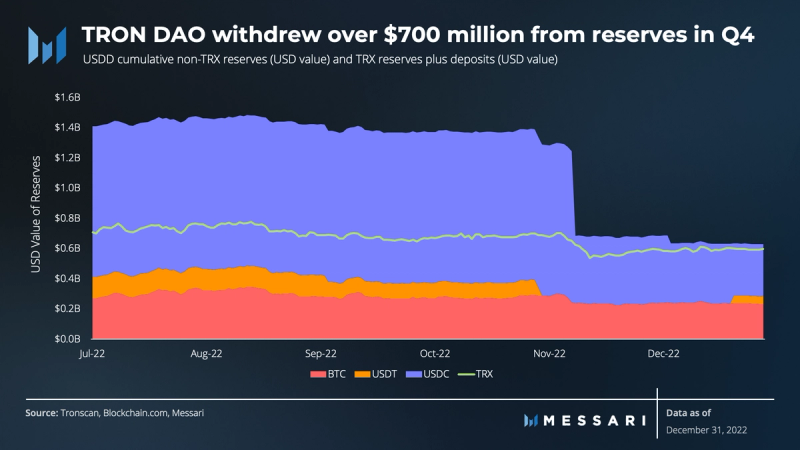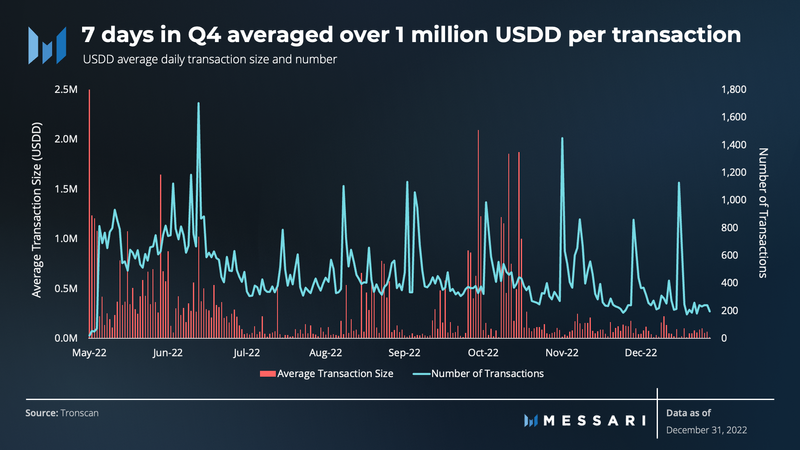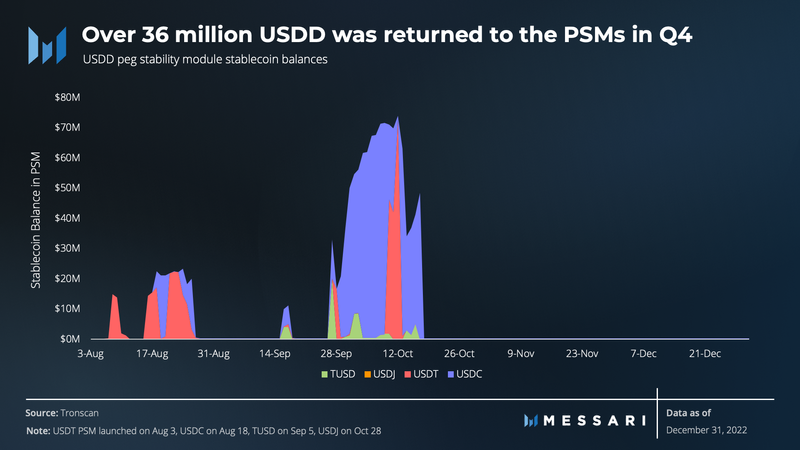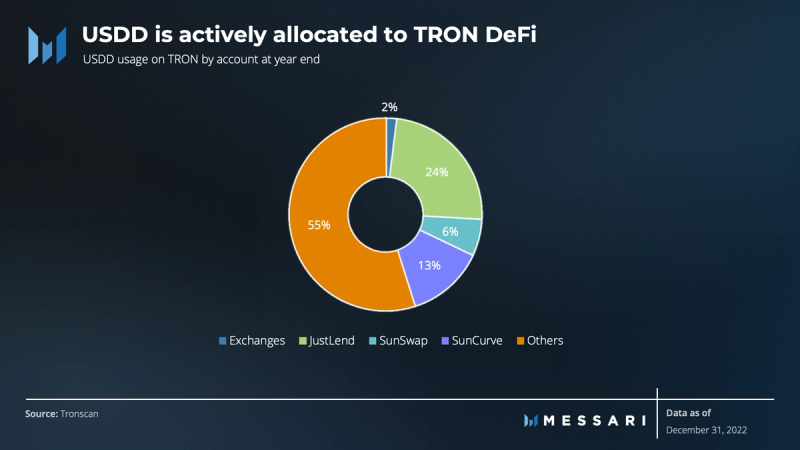Key Insights
- The FTX collapse and market volatility led the TRON DAO to move reserves, leaving USDD undercollateralized if only stablecoins and BTC reserves are taken into account. Including TRX deposits, the stablecoin is sufficiently over-collateralized.
- Supply remained unchanged for the quarter.
- Volumes increased 27% in Q4, and the number of wallets holding USDD increased 8%.
- USDD has been trading below its peg since October, leading to an empty PSM and an imbalanced Curve pool.
Primer on USDD
USDD is an over-collateralized stablecoin issued by the TRON DAO Reserve (TDR), which is also the custodian. The TDR is made up of seven crypto-native institutions. USDD’s value is backed by the over-collateralization of crypto assets under the TDR, including BTC, USDT, USDC, and TRX. The peg is maintained through the Peg Stability Module (PSM) that allows 1:1 transfer of USDD for USDT, USDC, TUSD, and USDJ. The PSM’s USDD funding is controlled by the TRON DAO Reserve. USDD can be minted by the whitelisted institutions of the TDR by depositing TRX.
Key Metrics

Performance Analysis
USDD Supply and TRX Deposit

USDD supply was flat in Q4, as measured by issuance from the circulation account. The primary method for minting new USDD is for the TRON DAO Reserve to deposit TRX into a staking account equal to the amount of USDD to be released. Since its inception, nearly 10% of TRX’s circulating supply has been deposited to back USDD.
Reserve Balances

In November, amid the market volatility surrounding the FTX collapse, the TRON DAO Reserve announced buybacks of 300 million and then 1 billion USDT. In total, the changes impacted the reserve wallets by removing 653 million USDC and 100 million USDT. However, 50 million USDT was added back in December. According to announcements made on Twitter and Discord, the reserves are being held on centralized exchanges. The value of the BTC reserves (14,015 BTC) fell with prices, but no changes occurred in the BTC wallet.
Adoption and Usage

Holders of USDD experienced minimal growth in Q4, especially compared to the torrid Q3. The number of wallets on TRON holding USDD increased nearly 8% to over 130,000. However, the number of senders decreased from 316,000 in Q3 to 257,000 in Q4. Adoption does not seem to be following a typical adoption curve. Instead, USDD saw a jump in the number of wallets holding the stablecoin, typically around market events.

Volumes increased 27.3% in Q4, as market volatility led to larger transactions. The average transaction in Q4 was 210,000 USDD, a 28% increase from Q3, where the average transaction was 164,000 USDD. Interestingly, the larger transactions in Q4 occurred in October, before the FTX-induced market volatility. There is a pattern for USDD of large transactions occurring at the beginning of the month. Based on clusters of lending transactions, this may be a lending strategy rebalancing at the beginning of each month. The number of transactions fell from 40,000 in Q3 to 35,000 in Q4, though transactions reacted to market volatility more predictably.
Peg and Location

Pursuant to the removal of some reserves from the reserve wallets, USDD has been trading below its 1-dollar peg level. The TRON DAO Reserve has TRX deposited in the burn account ($492 million) as well as in reserve wallets ($105 million) that it can sell in exchange for USDD to reduce supply. Thus far, however, there have been no changes to the TRX balances. Not including TRX, the collateral ratio for the stablecoin is below 1 at 0.87, measuring the value in the reserve wallets. Including TRX in the reserve wallets and deposited in the burn account, the collateral ratio is 1.7.

The depeg also led to an increase in activity in the PSMs. The PSMs primarily maintain the peg when it trades above 1, as users can buy USDT, USDC, TUSD, or USDJ and deposit them into the PSM for a 1:1 exchange of USDD. This allowed the PSM to build up a balance of over 30 million stablecoins entering Q4. The PSM is only effective at supporting the peg below 1 as long as the PSM is funded, which was no longer the case by the end of October. Over 36 million non-USDD stablecoins (primarily USDC) were removed from the PSM, in exchange for USDD.

The TRON DAO also uses a Curve pool to help maintain liquidity for USDD on Ethereum and the stablecoin peg. The pool contains USDD and 3CRV, Curve’s DAI/USDC/USDT stablecoin pool. Entering Q4, the pool contained $32 million in USDD and $37 million in 3CRV. By the end of the quarter, over $30 million of value left the pool in the form of 3CRV, leaving less than $7 million of 3CRV compared to over $30 million in USDD. For users looking to sell their USDD on Ethereum, there is only 7 million of liquidity available (in the primary liquidity pool).

Currently, roughly 75% of USDD on TRON is held in smart contract accounts. The remaining 25% is in general accounts (user wallets). USDD is a significant part of DeFi on TRON, with a quarter of USDD on the lending platform JustLend and another 20% on decentralized exchanges SunSwap and SunCurve. Of the remaining “Others” portion, roughly half is locked in a bridge contract supporting USDD on other chains while the remainder is in general accounts.
Qualitative Analysis
Travala Partnership
In October, USDD and Travala announced a partnership that integrates USDD as a payment option on the travel site. Travala is “the world’s leading blockchain-based travel booking platform trusted by thousands of customers worldwide as their preferred online travel agency.” With over 1,900 reviews on TrustPilot, Travala offers over 2 million properties to book as well as flights to get there. The site accepts multiple types of digital currencies for payment, and adding USDD is an important signal of adoption for the TRON-native stablecoin.
USDJ Added to the PSM
On October 28, the TRON DAO Reserve added the ability to swap USDJ for USDD 1:1 through the Peg Stability Module. USDJ is the stablecoin minted in the JustLendDAO ecosystem in exchange for debt collateral utilizing the well-known collateral debt position mechanism (DAI for TRON). The integration shows the ability of USDD to promote DeFi throughout TRON’s ecosystem and create a positive loop on the blockchain.
Closing Summary
The TRON DAO Reserve will likely need to remove supply to return USDD to its peg, either by releasing reserves or selling TRX. This would restore confidence in the stablecoin by adding reserves back to the public reserve addresses rather than keeping them on Centralized Exchanges. The volatility in the fourth quarter led to increased volume of USDD, and the number of wallets holding the stablecoin also grew. Partnerships like Travala and integrations such as USDJ are important for increased adoption and use cases both in, and beyond, DeFi.



















